Abstract
摘要
1. Introduction
1. 引言
Indoor scenes are essential to urban environments. Current urban studies necessitate understanding indoor scene semantic information for tasks like emergency evacuation [38], robotic navigation [36], and virtual reality [43]. The dynamic nature of indoor scenes demands perception of env iron mental changes in real time for tasks such as emergency evacuation [38], stressing the importance of algorithms’ real-time capabilities. Existing real-time semantic segmentation methods often falter when applied to the complex semantic information of indoor scenes, usually requiring a sacrifice in accuracy [40]. This often requires a trade-off between inference speed and increased network complexity to achieve adequate segmentation accuracy indoors. Consequently, a critical research question is how to improve the accuracy of semantic segmentation in indoor environments without substantially increasing complexity, while ensuring real-time performance.
室内场景是城市环境的重要组成部分。当前的城市研究需要理解室内场景的语义信息,以支持应急疏散[38]、机器人导航[36]和虚拟现实[43]等任务。室内场景的动态特性要求实时感知环境变化,例如应急疏散场景[38],这凸显了算法实时能力的重要性。现有的实时语义分割方法在处理室内场景复杂语义信息时往往表现不佳,通常需要以牺牲精度为代价[40]。这常常需要在推理速度与增加网络复杂度之间进行权衡,以实现室内场景的充分分割精度。因此,一个关键的研究问题是如何在不显著增加复杂度的前提下提升室内环境语义分割的准确性,同时确保实时性能。
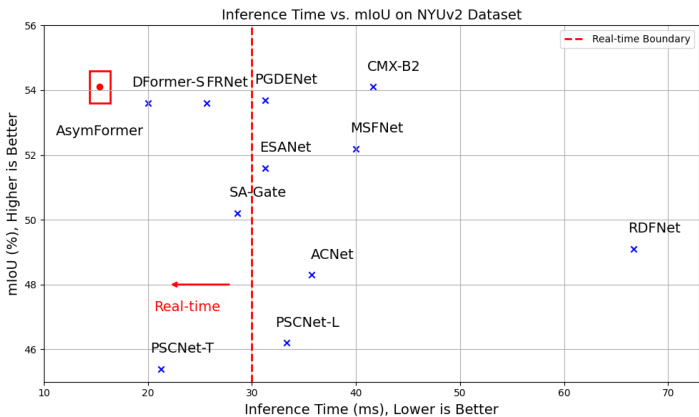
Figure 1. The AsymFormer has 33.0 million parameters and 36.0 GFLOPs computational cost, and it can achieve 65 FPS inference speed on RTX 3090, $54.1%$ mIoU on NYUv2.
图 1: AsymFormer 拥有 3300 万参数和 36.0 GFLOPs 计算量,在 RTX 3090 上可实现 65 FPS 的推理速度,在 NYUv2 数据集上达到 54.1% mIoU。
Aside from increasing the complexity of the network, introducing additional information, such as RGB-D data, is also an effective way to improve the accuracy of semantic segmentation networks. RGB-D cameras are widely used devices for indoor information acquisition. RGB-D information consists of RGB (color, texture and shape) and
除了增加网络复杂度外,引入RGB-D数据等额外信息也是提升语义分割网络精度的有效方法。RGB-D相机是广泛应用的室内信息采集设备,其数据包含RGB(色彩、纹理和形状)与深度信息。
Depth (boundaries and relative location) features, which are somewhat complementary [42]. Several studies have explored how to improve indoor scene semantic segmentation performance by integrating RGB-D information [26, 42, 50].
深度(边界和相对位置)特征,这些特征在某种程度上是互补的[42]。多项研究探讨了如何通过整合RGB-D信息来提升室内场景语义分割的性能[26, 42, 50]。
Existing research has explored the implementation of attention mechanisms to extract valuable information from RGB-D features without significantly increasing computational complexity. However, due to the additional feature extraction branch for depth features and the lack of discussion on how to allocate computational resources based on feature importance, these methods often introduce a substantial amount of redundant parameters, significantly reducing their computational efficiency [9].
现有研究探索了通过注意力机制从RGB-D特征中提取有价值信息而不显著增加计算复杂度的实现方式。然而,由于深度特征需要额外的特征提取分支,且缺乏关于如何根据特征重要性分配计算资源的讨论,这些方法通常会引入大量冗余参数,显著降低计算效率 [9]。
To address this issue, this paper introduces AsymFormer, a high-performance real-time network for RGB-D semantic segmentation that employs an asymmetric backbone design. This includes a larger parameter backbone for important RGB features and a smaller backbone for the Depth branch. Regarding framework selection, at the same computational complexity, Transformer often achieves higher accuracy but has a slower inference speed compared to CNN [19]. In order to speed up the main branch, this paper employ a hardware-friendly CNN [21] for the RGB branch and a light-weight Transformer [35] for the Depth branch to further compress the parameters. Considering the differences between different modal representation, to effectively select and fuse asymmetric features, this paper proposes a learnable method for feature information compression and constructs a Local Attention Guided Feature Selection (LAFS) module. Additionally, a Cross-Modal Attention (CMA) module is introduced to embed cross-modal information into pixel-wise fused features. Finally, we employ a lightweight MLP-Decoder[35] to decode semantic information from shallow features.
为解决这一问题,本文提出了AsymFormer,一种采用非对称主干设计的高性能实时RGB-D语义分割网络。该设计包含一个参数较多的主干用于处理重要RGB特征,以及一个较小的主干用于深度分支。在框架选择方面,在相同计算复杂度下,Transformer通常能达到更高精度但推理速度慢于CNN [19]。为加速主分支,本文为RGB分支采用了硬件友好的CNN [21],为深度分支采用轻量级Transformer [35]以进一步压缩参数量。考虑到不同模态表征的差异,为有效选择和融合非对称特征,本文提出了一种可学习的特征信息压缩方法,并构建了局部注意力引导的特征选择(LAFS)模块。此外,还引入了跨模态注意力(CMA)模块,将跨模态信息嵌入到逐像素融合特征中。最后,我们采用轻量级MLP解码器[35]从浅层特征解码语义信息。
This paper evaluates AsymFormer on two classic indoor scene semantic segmentation datasets: NYUv2 and SUNRGBD. Meanwhile, the inference speed test is also preformed on Nvidia RTX 3090 platform. The AsymFormer achieves $54.1%$ mIoU on NYUv2 and 49.1 mIoU on SUNRGBD, with 65 FPS inference speed (79 FPS with mixed precision quantization using the TensorRT). Our experiments highlight AsymFormer’s ability to acquire high accuracy and efficiency at the same time. The main contributions are summarized as follows:
本文在NYUv2和SUNRGBD两个经典室内场景语义分割数据集上评估了AsymFormer性能,并在Nvidia RTX 3090平台进行了推理速度测试。AsymFormer在NYUv2上达到54.1% mIoU,在SUNRGBD上达到49.1 mIoU,推理速度为65 FPS (使用TensorRT混合精度量化后可达79 FPS)。实验结果表明AsymFormer能够同时实现高精度与高效率。主要贡献总结如下:
features, validating its capability to enhance network accuracy with minimal additional model parameters.
特征,验证了其能以最少的额外模型参数提升网络精度的能力。
2. Related Works
2. 相关工作
2.1. Indoor Scene Understanding
2.1. 室内场景理解
Current research in indoor scene understanding leverages diverse data sources, including RGB images [2], RGB-D images [42], point clouds [51], and mesh data [45]. Each of these sources provides unique insights and benefits for analyzing and interpreting indoor environments. For instance, RGB images are accessible and straightforward for visual representations, whereas point clouds and meshes offer intricate 3D spatial data. However, when considering the simultaneous use of both 2D and 3D information to optimize efficiency and effectiveness in scene understanding, RGB-D images emerge as the optimal choice.
当前室内场景理解研究利用多种数据源,包括RGB图像[2]、RGB-D图像[42]、点云数据[51]和网格数据[45]。每种数据源都为分析和解读室内环境提供了独特的视角与优势。例如,RGB图像易于获取且适合视觉呈现,而点云和网格则能提供精细的三维空间数据。然而,当需要同时运用2D与3D信息以优化场景理解的效率与效果时,RGB-D图像成为最佳选择。
2.2. RGB-D Representation Learning
2.2. RGB-D 表征学习
One of the earliest works on RGB-D semantic segmentation, FCN [22], treated RGB-D information as a single input and processed it with a single backbone. However, subsequent works have recognized the need to extract features from RGB and Depth information separately, as they have different properties. Therefore, most of them have adopted two symmetric backbones for RGB and Depth feature extraction [5, 26, 27, 42]. Primarily, asymmetric backbones doubles the overall computational complexity [9]. However, it is generally observed that for semantic segmentation, RGB information typically plays a more prominent role than Depth information, as indicated by [9]. Using a asymmetric backbone for feature extraction will obviously lead to redundant parameters on the less important side, reducing the efficiency of the network.
RGB-D语义分割的早期工作之一FCN [22]将RGB-D信息视为单一输入并用单一主干网络处理。但后续研究认识到需要分别从RGB和深度信息中提取特征,因其特性不同。因此多数方法采用两个对称主干网络分别进行RGB和深度特征提取[5, 26, 27, 42]。非对称主干网络主要会使整体计算复杂度翻倍[9]。然而研究表明,对于语义分割任务,RGB信息通常比深度信息起更重要作用[9]。使用非对称主干网络进行特征提取显然会在重要性较低的一侧产生冗余参数,降低网络效率。
2.3. RGB-D feature fusion
2.3. RGB-D特征融合
The performance and efficiency of different frameworks depends largely on how they fuse RGB and Depth features. Some early works, such as RedNet [17], fused RGB and Depth feature maps pixel-wise in the backbone. Later, ESANet series [26, 27] proposed channel attention to select features from different channels, as RGB and Depth feature maps may not align well on the corresponding channels. PSCNet [9] further extended channel attention to both spatial and channel directions and achieved better performance. Recently, more complex models have been proposed to exploit cross-modal information and select features for RGBD fusion. For example, SAGate [5] proposed a gated attention mechanism that can leverage cross-modal information for feature selection. CANet [47] extended non-local attention [32] to cross-modal semantic information and achieved significant improvement. CMX [42] extended SA-Gate to spatial and channel directions and proposed a novel crossmodal attention with global receptive field. However, integrating cross-modal information and learning cross-modal similarity is still an open question in vision tasks.
不同框架的性能和效率很大程度上取决于它们如何融合RGB和深度特征。早期工作如RedNet [17]在主干网络中采用像素级方式融合RGB与深度特征图。随后,ESANet系列[26, 27]提出通道注意力机制,从不同通道选择特征,因为RGB和深度特征图在对应通道上可能无法很好对齐。PSCNet [9]进一步将通道注意力扩展到空间和通道两个维度,取得了更好的性能。近期,更复杂的模型被提出以利用跨模态信息并进行RGBD融合的特征选择。例如,SAGate [5]提出了一种门控注意力机制,能够利用跨模态信息进行特征选择。CANet [47]将非局部注意力[32]扩展到跨模态语义信息,实现了显著提升。CMX [42]将SA-Gate扩展到空间和通道维度,并提出具有全局感受野的新型跨模态注意力机制。然而,在视觉任务中整合跨模态信息并学习跨模态相似性仍是一个开放性问题。
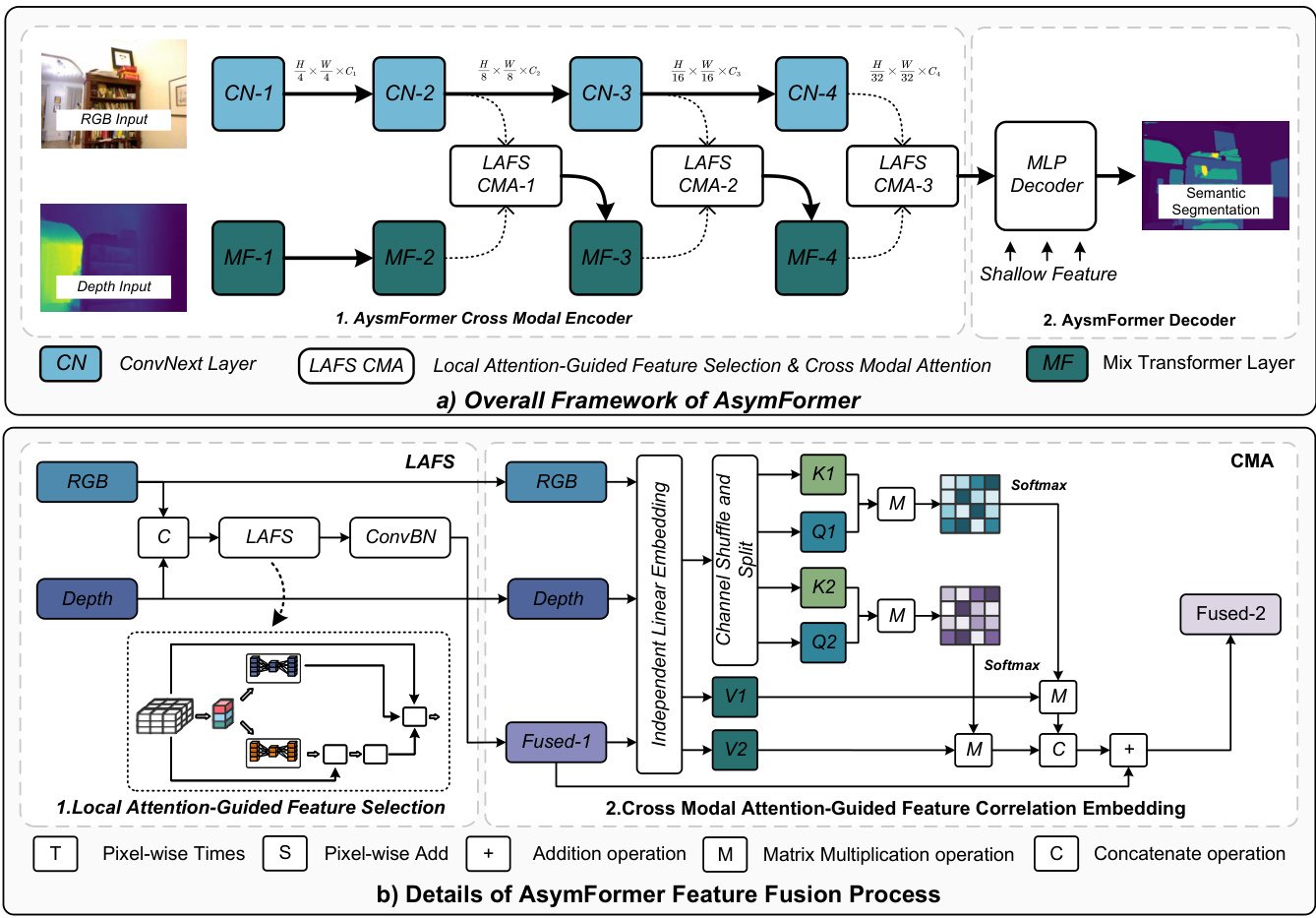
Figure 2. Overview of AsymFormer.
图 2: AsymFormer 架构概览
3. Method
3. 方法
3.1. Framework Overview
3.1. 框架概述
This paper develops a high-accuracy real-time semantic segmentation method, AsymFormer, which leverages an asymmetric backbone network to mine multimodal representations. A hardware friendly convolution network ConvNext [21] is used for RGB feature extraction and a lightweight Mix-Transformer [35]is used for processing Depth feature. To effectively fuse RGB-D features, the study introduces a Local Attention Guided Multimodal Feature Selection (LAFS) module, which uses learnable strategy to extract global information and selects multimodal features in both spatial and channel dimensions. Moreover, to further mine the information contained in multimodal features, the study embeds the information contained in multimodal features through a novel Cross-Modal Attention (CMA) module. The overall framework of AsymFormer is shown in Fig.2.
本文提出了一种高精度实时语义分割方法AsymFormer,该方法利用非对称主干网络挖掘多模态表征。研究采用硬件友好的卷积网络ConvNext [21]提取RGB特征,使用轻量级Mix-Transformer [35]处理深度特征。为有效融合RGB-D特征,研究提出了局部注意力引导的多模态特征选择(LAFS)模块,该模块通过可学习策略提取全局信息,并在空间和通道维度上选择多模态特征。此外,为深度挖掘多模态特征中的信息,研究通过新型跨模态注意力(CMA)模块嵌入多模态特征信息。AsymFormer的整体框架如图2所示。
3.2. Local Attention Guided Feature Selection
3.2. 局部注意力引导的特征选择
Studies have shown that attention mechanisms can effectively select complementary features from RGB and Depth features, thereby improving the efficiency of feature extraction and the performance of semantic segmentation [9, 16, 40, 42]. However, existing attention mechanisms usually adopt a non-learnable, fixed strategy for feature information compression [34], which may overlook the differences among various modal features, causing insufficient use of information.
研究表明,注意力机制能有效从RGB和深度特征中选择互补特征,从而提升特征提取效率和语义分割性能 [9, 16, 40, 42]。但现有注意力机制通常采用不可学习的固定策略进行特征信息压缩 [34],可能忽略不同模态特征的差异性,导致信息利用不足。
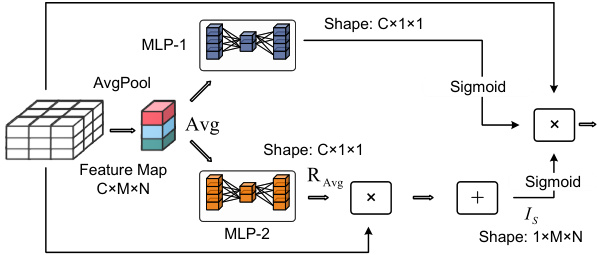
Figure 3. LAFS.
图 3: LAFS
In response to this issue, this paper proposes a learnable method for feature information compression and constructs a Local Attention Guided Feature Selection (LAFS) module. The core design of LAFS is a learnable method for spatial information compression. Inspired by SE [14] attention,
针对这一问题,本文提出了一种可学习的特征信息压缩方法,并构建了局部注意力引导特征选择(LAFS)模块。LAFS的核心设计是一种可学习的空间信息压缩方法,其灵感来源于SE [14]注意力机制。
LAFS abandons traditional fixed strategies and employs a feed forward neural network to learn a set of dynamic spatial information compression rules.
LAFS摒弃了传统的固定策略,采用前馈神经网络来学习一组动态空间信息压缩规则。
The Fig. 3 demonstrates details of the LAFS module. The input features to the LAFS module are the tensor concatenation of $R G B$ and Depth features. For computing attention weights, the study first extracts a global information vector $A v g$ through Adaptive Average Pooling. For channel attention, its structure is the same as SE [14].
图 3: 展示了LAFS模块的细节。LAFS模块的输入特征是将RGB和深度(Depth)特征张量拼接而成的。为了计算注意力权重,该研究首先通过自适应平均池化(Adaptive Average Pooling)提取全局信息向量$Avg$。在通道注意力方面,其结构与SE [14]相同。
On spatial attention computation, which is the primary improvement, the LAFS first processes global information $A v g$ through another feed forward neural network with a squeeze-excitation structure, producing the output vector $R_{A v g}$ , representing pixel space similarity descriptions. Then, by computing the dot product similarity between $R_{A v g}$ and input feature map, the global spatial information $I_{S}$ is extracted (this equates to a weighted sum of the channel features, dynamically varying with $A v g$ changes). Subsequently, spatial attention weights $W_{S}$ are calculated through sigmoid normalization.
在空间注意力计算这一主要改进点上,LAFS首先通过另一个带有压缩激励结构的前馈神经网络处理全局信息 $A v g$,生成输出向量 $R_{A v g}$,表示像素空间相似性描述。接着,通过计算 $R_{A v g}$ 与输入特征图之间的点积相似度,提取全局空间信息 $I_{S}$(这相当于通道特征的加权求和,随 $A v g$ 变化动态调整)。随后,通过sigmoid归一化计算出空间注意力权重 $W_{S}$。
$$
W_{S}={\mathrm{Sigmoid}}({\frac{{\mathrm{Dot}}(I n p u t.{\mathrm{Reshape}}(C,H\times W)^{T},R_{A v g})}{C^{2}}})
$$
$$
W_{S}={\mathrm{Sigmoid}}({\frac{{\mathrm{Dot}}(I n p u t.{\mathrm{Reshape}}(C,H\times W)^{T},R_{A v g})}{C^{2}}})
$$
Here, all results are divided by $C^{2}$ to prevent sigmoid overflow. Finally, input features are selected based on the pixelwise multiplication of feature maps with spatial and channel attention weights.
此处将所有结果除以 $C^{2}$ 以防止sigmoid函数溢出。最终,基于特征图与空间及通道注意力权重的逐像素相乘来选择输入特征。
3.3. Cross-Attention Guided Feature Embedding
3.3. 跨注意力引导的特征嵌入
Aside from selecting existing features, it is necessary to mine new information from fused features. Existing MultiHead Self-Attention (MHSA) in Transformer [31] is limited to learning self-similarity within a single modality, whereas mining information from multi-modal jointly is a new goal in representation learning. In this paper, a new Cross-Modal Attention (CMA) module is constructed. The key to CMA is defining cross-modal self-similarity using a linear sum, and embedding its result into the fused features.
除了选择现有特征外,还需从融合特征中挖掘新信息。Transformer [31] 中现有的多头自注意力 (MHSA) 仅能学习单模态内的自相似性,而联合多模态挖掘信息是表征学习的新目标。本文构建了一个新的跨模态注意力 (CMA) 模块,其核心是通过线性求和定义跨模态自相似性,并将结果嵌入融合特征中。
3.3.1 Definition of Cross-Modal Self-Similarity:
3.3.1 跨模态自相似性定义:
Suppose $R G B$ and Depth features are seamlessly embedded into $K e y$ and Query, then for a pixel $(i_{0},j_{0})$ , its crossmodal self-similarity with other pixels $(i,j)$ can be defined as:
假设 $RGB$ 和深度 (Depth) 特征被无缝嵌入到 $Key$ 和 $Query$ 中,那么对于像素 $(i_{0},j_{0})$ ,其与其他像素 $(i,j)$ 的跨模态自相似性可定义为:
$$
W(i,j)=\sum_{n=1}^{N}(K r_{n,i,j}.Q r_{n,i_{0},j_{0}})+\sum_{n=1}^{N}(K d_{n,i,j}.Q d_{n,i_{0},j_{0}})
$$
$$
W(i,j)=\sum_{n=1}^{N}(K r_{n,i,j}.Q r_{n,i_{0},j_{0}})+\sum_{n=1}^{N}(K d_{n,i,j}.Q d_{n,i_{0},j_{0}})
$$
where $K r_{n,i,j}$ represents the nth feature value of the pixel $K e y_{R G B}$ , and $Q r_{n,i,j}$ represents the nth feature value of the pixel $Q u e r y_{R G B}$ . Similarly, $K d_{1,i,j}$ and $Q d_{1,i,j}$ represent the nth feature value of the pixel $K e y_{D e p t h}$ and QueryDepth respectively.
其中 $K r_{n,i,j}$ 表示像素 $K e y_{R G B}$ 的第n个特征值,$Q r_{n,i,j}$ 表示像素 $Q u e r y_{R G B}$ 的第n个特征值。同理,$K d_{1,i,j}$ 和 $Q d_{1,i,j}$ 分别表示像素 $K e y_{D e p t h}$ 和 QueryDepth 的第n个特征值。
3.3.2 Feature Embedding
3.3.2 特征嵌入
The CMA has three input features, namely $R G B$ features, Depth features, and the fused features F used selected by LAFS. In the calculation process of CMA, the first step is to embed the input features RGB, Depth, and F used into vector space.
CMA具有三个输入特征,即$R G B$特征、深度(Depth)特征以及由LAFS选择使用的融合特征F。在CMA的计算过程中,首先将输入特征RGB、Depth和F used嵌入到向量空间。
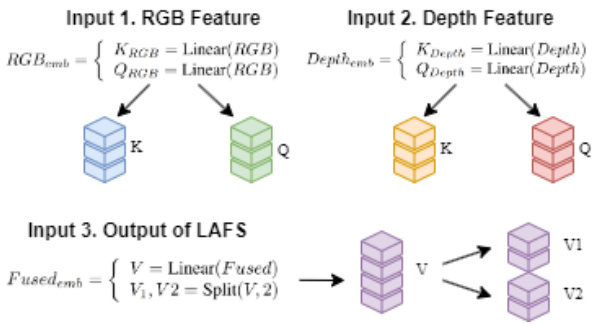
Figure 4. Feature Embedding.
图 4: 特征嵌入 (Feature Embedding)。
Simultaneously, the output V alue split into two independent vectors $V_{1}$ and $V_{2}$ in the channel direction.
同时,输出值V在通道方向上分裂为两个独立向量$V_{1}$和$V_{2}$。
3.3.3 Splitting and Mixing of Multimodal Information
3.3.3 多模态信息的分割与混合
To learn features from multiple subspaces, the embedded features $K_{R G B}$ , $K_{D e p t h}$ , $Q_{R G B}$ , and $Q_{D e p t h}$ are split into two independent vectors.The study first concatenates $K e y_{R G B+D e p t h}$ with $Q u e r y_{R G B+D e p t h}$ in the channel direction, obtaining Key and Query:
为了从多个子空间学习特征,嵌入特征$K_{R G B}$、$K_{D e p t h}$、$Q_{R G B}$和$Q_{D e p t h}$被拆分为两个独立向量。研究首先在通道方向上拼接$Key_{R G B+D e p t h}$与$Query_{R G B+D e p t h}$。
It can be noted that if the vectors are directly split and self-similarity is calculated in different subspaces, it might result in the inability to simultaneously include RGB and Depth features in different subspaces. Therefore, we introduce a Shuffle mechanism to ensure each $K1,K2,Q1$ , and $Q2$ contain information from both modalities. As shown in Figure 4.
可以注意到,如果直接分割向量并在不同子空间中计算自相似性,可能导致无法同时在不同子空间中包含RGB和Depth特征。因此,我们引入了一种Shuffle机制,以确保每个$K1,K2,Q1$和$Q2$都包含来自两种模态的信息。如图4所示。
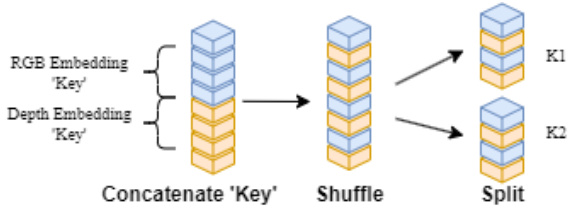
Figure 5. Splitting and Mixing of Multimodal Information.
图 5: 多模态信息的分割与混合。
After channel shuffle, CMA can ensure that both RGB and Depth information can be utilized simultaneously when calculating self-similarity.
通道混洗后,CMA能确保在计算自相似性时同时利用RGB和深度信息。
3.3.4 Representation Learning in Multiple Subspaces
3.3.4 多子空间表征学习
Finally, CMA calculates the cross-modal similarity and embeds the calculation result into the fused feature V alue,
最后,CMA计算跨模态相似度并将计算结果嵌入到融合特征V alue中,
similar to operations in [8, 31, 32]. Specifically, the study computes the dot products $K_{1},Q_{1}$ and $K_{2},Q_{2}$ to derive two representations of subspaces $W_{1}$ and $W_{2}$ :
类似于[8, 31, 32]中的操作。具体而言,该研究计算点积$K_{1},Q_{1}$和$K_{2},Q_{2}$,以推导出子空间$W_{1}$和$W_{2}$的两种表示:
$$
\begin{array}{r}{W_{1}=\mathrm{Softmax}(\frac{Q_{1}\cdot K_{1}^{T}}{\sqrt{C_{1}/4}})}\ {W_{2}=\mathrm{Softmax}(\frac{Q_{2}\cdot K_{2}^{T}}{\sqrt{C_{1}/4}})}\end{array}
$$
$$
\begin{array}{r}{W_{1}=\mathrm{Softmax}(\frac{Q_{1}\cdot K_{1}^{T}}{\sqrt{C_{1}/4}})}\ {W_{2}=\mathrm{Softmax}(\frac{Q_{2}\cdot K_{2}^{T}}{\sqrt{C_{1}/4}})}\end{array}
$$
Then, $W_{1}$ and $W_{2}$ embed information into $V_{1}$ and $V_{2}$ through dot products. The fused feature $F u s e d_{2}$ is the concatenation of $V_{1}$ and $V_{2}$ in the channel dimension:
接着,$W_{1}$ 和 $W_{2}$ 通过点积将信息嵌入到 $V_{1}$ 和 $V_{2}$ 中。融合特征 $Fused_{2}$ 是 $V_{1}$ 和 $V_{2}$ 在通道维度上的拼接:
$$
F u s e d=\mathbf{Cat}[W_{1}\cdot V_{1},W_{2}\cdot V_{2}]
$$
$$
F u s e d=\mathbf{Cat}[W_{1}\cdot V_{1},W_{2}\cdot V_{2}]
$$
Finally, CMA converts $F u s e d_{2}$ into output channels $C_{2}$ using a linear layer and connects it with the residual connection F used, resulting in CMA’s output feature.
最后,CMA通过线性层将$Fused_{2}$转换为输出通道$C_{2}$,并与残差连接Fused相连,生成CMA的输出特征。
4. EXPERIMENT RESULTS
4. 实验结果
4.1. Implementation Details
4.1. 实现细节
To evaluate our Real-Time semantic segmentation network design, we conduct a series of experiments on two widelyused datasets NYUv2[28] (795 training and 654 testing RGB-D images) and SUNRGBD[30] (5825 training and 5050 testing RGB-D images). We conduct the model training and testing on different platforms. For the training, we use Nvidia A100-40G GPU. For the evaluation and inference speed testing, we use Nvidia RTX 3090 GPU, Ubuntu 20.04, CUDA 12.0 and Pytorch 2.0.1. We apply data augmentation to all datasets by randomly flipping $(\mathtt{p}{=}0.5)$ , random scales between 1.0 and 2.0, random crop $480\times640$ and random HSV. We adopt ConvNext-T [21] backbones pretrained on ImageNet-1k[6]. For the Mix TransformerB0 [35], no pre-trained weight has been used. The MLPdecoder in AsymFormer has the s
